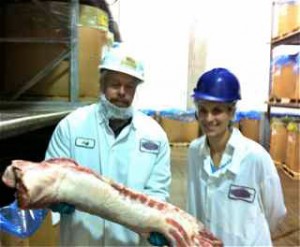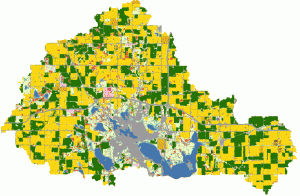We recently completed an “actionable” watershed phosphorus balance, leading to development of a P balance tool (see below) to aid watershed managers in developing watershed nutrient reduction strategies.
Project: Using watershed P balances to support TMDL plans.
Project team: L. Baker, John Nieber, and Bruce Wilson (PIs); Heidi Peterson (post-doc, in photo), Jason Ulrich, and Nick Moore.
Funding: EPA 319 program, through MPCA.
Downloadable Products:
Peterson, H.M., L. Baker, J. Ulrich, J. Nieber, B. Wilson. Quantifying the upstream flux of phosphorus to Minnesota’s Twin Cities urban food-shed, CHANS Fellow presentation at the Ecological Society of America Conference, August 7, 2013.
Baker, L. A., H.M. Peterson, D. Bruening, J. Nieber, B.N, Wilson, J. Ulrich. 2014. Users Manual: Phosphorus And Water Balance Tools For TMDL Plans. Report to the Minnesota Pollution Control Agency, Sept. 2014.
Peterson, H.M., and L. A. Baker. 2014. Agricultural P Calculator (to download Excel spreadhseet).
Baker, L.A. 2014. Urban spreadsheet P balance calculator (to download Excel spreadsheet).
Baker, L.A. H.M. Peterson, J. Ulrih,, J. Nieber1, and B. Wilson. 2014. Phosphorus Balance For The Albert Lea Region: Summary Report to the Shell Rock River Watershed District and the Minnesota Pollution Control Agency, Sept. 2014.
Baker, L. A, and H.M. Peterson. Watershed P balances as a tool for TMDL planning. Videoconference at the Minnesota Pollution Control Agency, April 24, 2014.
Finally, we have a forthcoming article coming out soon:
Peterson, H., L. Baker, J. Ulrich, J. Neiber, B. Wilson, and D. Bruening. In press. Using agricultural system phosphorus balances to improve the TMDL process Detailed P balance for the Albert Lea agricultural watershed: a tool for practical management. Soil and Water Conservation.
If you would like to receive a copy as soon as it is published, please send me an email ([email protected]).
Project Synopsis
The goal of this project was to develop tools to support implementation of TMDL plans. Two types of tools were developed: (1) a detailed P balance tool, with accompanying spreadsheet tools for urban and agricultural systems; and (2) a
The idea behind using watershed P balances to improve water quality is that an imbalance of P that occurs when more P enters the watershed than leaves via deliberate exports (things like meat, milk, eggs, and grains) results in soil accumulation of available P in soils. Since stream P is correlated with available soil P, this accumulation eventually results in higher stream P. Conversely, when P inputs to a watershed are lower than are exported deliberately, then the soil P is “mined” down, decreasing available P and eventually resulting in lower stream P levels – which is desirable.
To develop these tools, we studied the Albert Lea watershed which includes the city of Albert Lea, Minnesota, which is surrounded by agricultural land. Most of the watershed is planted in corn and soybean; the main animal operations are hog, dairy, beef, and turkeys.
The completed watershed P balance (figure below) shows that P inputs (piglets and fertilizer) are less than deliberate P outputs (pork, beef, milk, and crops). This means that P use efficiency is greater than 1.0, implying that crops are “mining” available soil P. Stream P export is 5% of input P.


